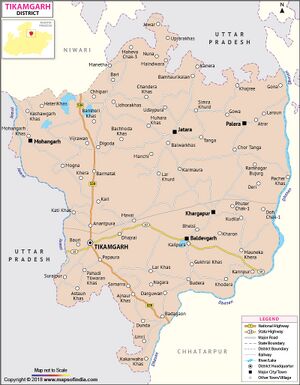Garh Kundar
| Author:Laxman Burdak, IFS (R) |

Garh Kundar (गढ़कुंडार) is a small village situated in Niwari district (earlier in Tikamgarh district) of Madhya Pradesh.
Origin
- Kundaraka was a Nagavanshi king who may have given name to this place. It has been named so after the splendid fort of Kundar located here. ‘Garh’ means ‘fort’. The name ‘Kundar’ is derived from Kundaraka. There was a pond in the village. It is said that the people used to get rid of their skin diseases after bathing in the pond. The remnants of the pond can still be seen near the temple of ‘Gajanan Maa’ near the fort. We find mention of Kundarika (कुण्डारिका) (Lady) in Mahabharata (IX.45.15) who became the companions when Skanda was installed.
Variants
- Garh Kundar (गढ़कुंडार) (जिला निवाड़ी, म.प्र.) (AS, p.273)
- Gadhkudhar (गढ़कुडार)
- Kudar (कुडार)
- Kundar (कुंडार)
- Garh Kundar (गढ़कुडार)
Jat clans
- Kundarwal (कुण्डरवाल)
History
Garh Kundar remained as the capital of Khangar kings till its capture by Mohammad Tughlaq’s army in 1347 A.D. Later it was handed over to Bundelas, who were feudatories of Mughals.
Besides the main fort the remains of various ancient structures can be seen here. These isolated remains seem to quietly narrate the tale of the splendid past of the Khangar Kshatriyas. It is in the large and spacious courtyard of the fort, princess Kesar De (daughter of last Khangar king Maharaja Man Singh) committed ‘Jauhar’ (a ritual of voluntary immolation by jumping into a pool of fire, undertaken in medieval times by the kshatriya queens and princesses to save their honour from the invading enemy). A few rock and pillar inscriptions have been found in the fort, which tell us the story of Kesar De’s sacrifice.
The Chief Minister of Madhya Pradesh announced a sum of rupees two crore forty-three lakhs for the conservation of historical fort of Kundar during a 3-day festival called "Virasat" held at the fort in December 2006.
Garh Kundar fort
The Garh Kundar fort is located on a high hill, surrounded by picturesque hills and forests. Besides the main fort, the remains of various ancient structures can be seen here. This quote has been built by Kate Singh, the chief of Prithviraj Chauhan's forces in 1531 at time of balban it is seized by the Bundela and remained their capital till 1531. These isolated remains seem to quietly narrate the tale of their splendid past. There is an ancient decaying temple of Gajanan Ma (an epithet of Goddess Durga, considered to be ‘Kula Devi’ by Khangars), built by Maharaja Khet Singh Khangar. There is also a temple of ‘Giddha Vahini’ Devi located here.
The fort has a complex built around a large and spacious courtyard. A few rock and pillar inscriptions have been found in the fort. Among the rough and overgrown stones, boulders and fallen masonry have been found the beautiful pillars of sun and moon. The granite flooring of the fort is said to have been renovated by the Bundela kings during Mughal period.
Kundar came into prominence after a chief of Khangars Khet Singh decided to build his capital here, in 1180s AD. He captured the fortress of Jinagarh from Chandelas, which was located here, and established his own state. After his death his grandson Maharaja Khub Singh Khangar built a splendid fort in place of Jinagarh fortress and named it ‘Garh Kundar’.
गढ़कुण्डार
विजयेन्द्र कुमार माथुर[1] ने लेख किया है ... गढ़कुण्डार (AS, p.273) मध्य प्रदेश के निवाड़ी ज़िले में गढ़कुण्डार के दुर्ग एवं नगर के भग्नावशेष बीहड़ पहाड़ों एवं वनों में बिखरे पड़े हैं। कभी गढ़कुण्डार चंदेल, खंगार एवं बुन्देल राजाओं की राजधानी रहा था। प्राचीन काल में कुण्डार प्रदेश पर गौंडो का राज्य था, जो पाटलिपुत्र के मौर्य सम्राटों को मंडलेश्वर मानते थे। परवर्ती काल में परिहार राजाओं ने कुण्डार पर आधिपत्य जमा लिया। आठवीं सदी के अंत में यहाँ चन्देलों का शासन था। पृथ्वीराज चौहान तृतीय का समकालीन चन्देल नरेश परमाल के समय यहाँ का दुर्गपाल शिवा नामक क्षत्रीय कीलेदार था जो परमाल के अधीन था. 1182 ई. में चौहान शासक एवं परमाल के बीच संघर्ष में शिवा मारा गया और चौहान के सैनिक खूबसिंह या खेतसिंह खंगार का कुंडार पर अधिकार हो गया। इसने खंगार राज्य क़ी नींव डाली, जो काफ़ी समय तक झाँसी के परिवर्ती इलाक़े में पर्याप्त समय तक राज्य करता रहा।
खंगारों से बुंदेला-वंशीय क्षत्रियों को ईर्ष्या थी और वे खंगारों को अपने से छोटा समझते थे. दिल्ली के गुलाम वंश के प्रसिद्ध सुल्तान बलबन के [p.274]: शासनकाल में बुंदेलों ने गढ़कुण्डार पर, जहाँ खंगारों की राजधानी थी, अधिकार कर लिया (1257 ई.) और युद्ध में खंगार शक्ति का पूर्ण रूप से विनास कर दिया. खंगार इस शक्ति के मद में चूर रहकर अत्यधिक मदिरापान करने लगे थे. इस युद्ध में खंगारों के सभी सरदार और सामंत मारे गए. बुंदेलों का नायक इस समय सोहनपाल था जिसकी संदरी कन्या रूपकुमारी और खंगार-नरेश हुरमत की दुखांत प्रणय-कथा बुंदेलखंड के चारणों के गीतों का प्रिय विषय है. बुंदेलों की राजधानी कुण्डार में 1507 ई. तक रही. इस वर्ष या संभवत: 1531 ई. में बुन्देला नरेश रुद्रप्रताप ने ओरछा बसाकर वहीं नई राजधानी बनायी। खंगारों और बुंदेलों में जो युद्ध हुआ उसका घटनास्थल कुंडार का दुर्ग ही था. इसके बाद यह नगर धीरे-धीरे खण्डहर में तब्दील हो गया। दुर्ग के खंडहर झाँसी नगर से 30 मील दूर हैं.
In Mahabharata
Kundarika (कुण्डारिका) (Lady) in Mahabharata (IX.45.15)
Shalya Parva, Mahabharata/Book IX Chapter 45 gives list of the mothers who became the companions when Skanda was installed. Kundarika (कुण्डारिका) (Lady) is mentioned in Mahabharata (IX.45.15).[2]
External links
References
- ↑ Aitihasik Sthanavali by Vijayendra Kumar Mathur, p.273274
- ↑ कुण्डारिका कॊकलिका कण्डरा च शतॊदरी, उत्क्राथिनी जरेणा च महावेगा च कङ्कणा (IX.45.15)

